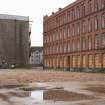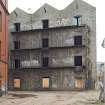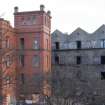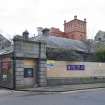Pricing Change
New pricing for orders of material from this site will come into place shortly. Charges for supply of digital images, digitisation on demand, prints and licensing will be altered.
Aberdeen, Maberly Street, Broadford Works, Raw Flax Warehouse
Flax Store (19th Century)
Site Name Aberdeen, Maberly Street, Broadford Works, Raw Flax Warehouse
Classification Flax Store (19th Century)
Alternative Name(s) Broadford Firehose And Canvas Works; Maberley Street
Canmore ID 291119
Site Number NJ90NW 125.06
NGR NJ 93661 06852
Datum OSGB36 - NGR
Permalink http://canmore.org.uk/site/291119
- Council Aberdeen, City Of
- Parish Aberdeen
- Former Region Grampian
- Former District City Of Aberdeen
- Former County Aberdeenshire
NJ90NW 125.06 93661 06852
Raw flax warehouses, the smaller block being granite clad and built c.1870. The larger turretted brick building was designed by Wilson and Walker in 1911-12) and has ferro-concrete (hennibique) floors. Both buildings have galleries for external access.
Triple gabled granite built flax warehouse with external spiral staircase to steel deck access. Stacks to rear of each gable, to dry out flax, hoists to front.Part of large group of textile manufacturing and storage buildings, granite and brick-clad, of iron-framed or reinforced concrete construction, with setted streets between them. Slate or flat concrete roofs.
The oldest iron-framed mill in Scotland and the fourth oldest known to survive in the world (after others of 1796, 1804 and 1805, all inter- related). The adjoining South Mill may be the third iron framed building in Scotland.
Built for Scott Brown and Co (of Angus), 1808, bankrupt 1811 and sold to Sir John Maberly MP, entrepreneur, speculator and introducer of jute to the UK. Maberley rapidly developed Broadford Works, adopting the first gas lighting of an industrial complex in Scotland, by Boulton and Watt in 1814-15, and Scotland's second power loom linen weaving factory in Scotland in 1824. Maberly was himself bankrupt and in 1834 the works passed to Richards and Co, who had a bleachworks at Rubislaw and branches at Montrose, produced canvas tarpaulins and as a particular specialism, fire hoses. Latterly man- made fibres for carpet yarn etc has replaced flax. Employment peaked at 3,000, once the largest single employer in Aberdeen. (Historic Scotland).
Standing Building Recording (2 October 2015 - 11 January 2017)
NJ 93609 06881 (NJ90NW 125) A standing building survey was carried out, 2 October 2015 – 11 January 2017, primarily of buildings to be demolished prior to the creation of an urban village. The current condition of the buildings being retained was also recorded.
Broadford Works was originally constructed by Fenton Murray and Wood of Leeds in 1808 for Scott Brown and Co. of Angus. It went bankrupt in 1811 and was sold to Sir John Maberly MP, entrepreneur, speculator and introducer of jute to the UK. Maberly rapidly developed Broadford Works,
adopting the first gas lighting of an industrial complex in Scotland, by Boulton and Watt in 1814–15, and Scotland’s second power loom linen weaving factory in Scotland in 1824. Maberly was himself bankrupt and in 1834 the works passed to Richards and Co., who had a bleachworks at
Rubislaw and branches at Montrose, and produced canvas tarpaulins, and as a particular specialism, fire hoses. In the 1830s the business was taken over by John Baker Richards, a London merchant. Under his ownership and name the company expanded through the 19th century. By the 1880s
eight steam engines drove the plant and some 3000 mill hands were employed. The company manufactured linen sheeting, towelling, sail canvas, tent cloth and hose web. Most of the buildings to be demolished were later additions and all the older mill buildings are being retained.
Archive: NRHE
Funder: First Construction Ltd
Alison Cameron - Cameron Archaeology
(Source: DES, Volume 18)


















